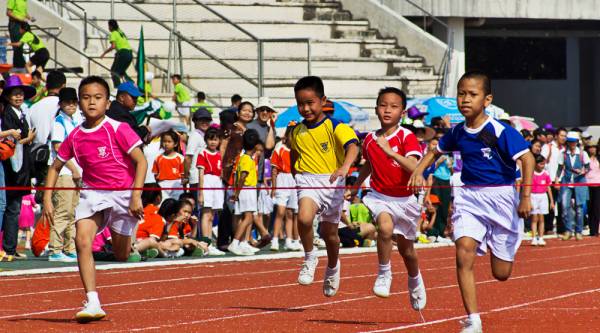Habits, more than anything else, dictate our behaviors and daily actions. But society has come to view habits as external conditions that happen to us. William James, the father of psychology, once said, “[A]ll our life… is but a mass of habits… bearing us irresistibly toward our destiny.”
No institution has more influence on habit formation than the public education system. So you would think America would be invested in creating positive health habits in their primary habit factories. But if aliens were to come to our planet, they’d be confused by what they found. They’d have to assume humans in America, for some reason, sought to program their youth from the very beginning for lives of poor health.
We aren’t just failing to teach our kids healthy habits. We’re actively forcing the opposite on them.
Inside the Bad Habit Factory
Take a walk through today’s education buildings. Students arrive at 7am or earlier, sleep-deprived. Often they haven’t eaten breakfast, and their fatigue and hunger combine to make them unable to resist the smell of cookies and fried Chick-fil-A wafting through the air. If that doesn’t get them, the vending machines will.
Students trudge to class, where they are glued to their seats and reprimanded if they attempt to get up. This pattern repeats, one hour at a time, all day. Their only reprieve from this immobile trance is when they walk to their next class, with eyes fixed on their cell phones, or while at P.E.
P.E. stands for Physical Education, but that could not be a greater misnomer. Little learning about human movement or health will take place. Long gone are the days of climbing ropes and being exposed to worthwhile sports and competitions. In today’s P.E., students routinely spend their time in jeans walking the track, or being given the option to either play pick-up basketball or sit and watch in the stands.
Where are the P.E. teachers? They, also, are sitting and watching.
But don’t blame the P.E. teachers. At a certain point they were beaten down by low societal expectations, and it became overwhelming to swim against the current. They are just a product of a system that has been devaluing P.E. for years. Most schools today require only one year of P.E. at the high school level. Our societal de-emphasis on health has created the current model.
Parents Aren’t Helping – Or Being Helped
School behaviors are an extension of society at large. They can be traced to parents, who have more influence than even the schools on sleep, eating, and texting habits. But the parents aren’t the root cause, either. After all, they spent their childhood in the same bad health habit factories – public schools.
And parents have precious little time to set positive examples, as they work unconscionable hours to provide for their kids, who are busier and more expensive than ever. If your child is an athlete, you’ve no doubt booked him or her with every specialist on the Internet. Your evenings are spent running to club practices, hitting lessons, quarterback coaching, or whatever else today’s parents/marketers/sports agents think they need to do to get their kid to the next level.
This specialized, guru-crazed culture has created kids with amazingly concentrated skill sets, but distressingly poor general athletic ability.
Our kids sit all day at school, eat poorly, play video games or text in any free moment, and then spend twenty hours a week with skills coaches. The result is kids who are less athletic and much more likely to have overuse injuries. As Eric Cressey explains, compared to ten years ago, today’s kids are “…less likely to be able to skip, to do a clean push up, to do a solid bodyweight overhead squat. We’ve dramatically detrained our kids.” Then we throw them into intense specialization and overuse of specific body parts.8
Former Atlanta Braves pitcher, John Smoltz, even referenced this in his Hall of Fame speech, where he pled with parents to re-evaluate how they bring up young baseball players. Smoltz says of kids: “They don’t go outside, they don’t have fun, they don’t throw enough – but they’re competing and maxing out too hard, too early, and that’s why we’re having these problems.”4
Sitting Themselves to Death
There is more at stake here than just youth athleticism and overuse injuries. The habits we teach in schools are creating health epidemics far more pervasive and costly than tobacco use. Yet unlike smoking, these habits are either ignored or accepted.
Our schools reinforce habits that are killing us faster than cigarettes once did. Sitting for more than two hours consecutively increases the risk of heart disease (America’s number one killer), diabetes, cancer, metabolic syndrome, and a host of postural problems. Perhaps more than any other subject, our schools are making kids experts in sitting for long periods of time.
A 2010 survey from the Kaiser Family Foundation found that our students sit, on average, 85 percent of their day.1 All the while, between 2002 and 2012, prescriptions for ADHD medications increased nearly 50 percent.2
Our kids need to move. Our culture is failing them.
In what world could we excuse ourselves for this indoctrination of our youth? It might sound drastic, but with the knowledge we now have, how is a reinforcing a student’s daily soda, cookie, and sitting habits any different than selling cigarettes in the vending machine? Culture is nothing more than the sum total of societal habits. We need a cultural change in the expectations of the school’s responsibility to promote health and wellness.

This could be an actual photo of a school lunch in any school in America.
Teach Our Kids How to Live
The argument in favor of change in our dominant school culture is overwhelming, but where do we begin? It starts with approaching P.E. and health as core subjects, essential to the life of every student.
Students should be taught health from a young age, with a focus on eating balanced meals, drinking water, and avoiding soda and candy in excess. Elementary education should focus on showing students the benefits of proper nutrition and lifestyle habits. There should be dire warnings of the dangers of unhealthy lifestyles, similar to the anti-cigarette movement.
At some point during their secondary education, all students should be taught to cook and plan healthy meals. P.E. should teach students how to move. Gymnastics, tumbling, and introduction to sports should be common from a young age. Specific tests like the functional movement screen (FMS) should be commonplace, in addition to other general benchmark tests, like push ups. As students reach high school, non-athletes should be required to be in P.E., and P.E. classes should become more specialized and focused. This gives students the chance to try more activities and progress them to mastery.
Eric Cressey speaks of a 39-year-old client who grew up in the Soviet Union. This man, despite living a sedentary lifestyle, was still able to do a muscle up and a “pseudo-gymnastics routine” on a whim.3 His body had learned kinesthetic awareness, proprioception, and a joy in movement, which will benefit him his whole life. How many American adults could say the same?
Change the Landscape in Education
We need more than a change in how we look at teaching health and P.E. We must re-examine how we think about the entire school day and the options presented to students:
- Vending Machines: What snacks are being sold in the halls? It makes sense that hungry students will visit the vending machine. An obvious step is to remove sodas and candy and replace them with water, mixed nuts, dried fruits, and other real foods.
- Lunch: School-provided lunches should be a high priority for educators. A sugar crash is a recipe for unfocused students. We have to put more thought into what our children are served at lunch. Chef Jamie Oliver has worked very hard at getting this message out, and his plan can be found here.
- Standing Desks: Standing desks are a common-sense solution to prevent students from being forced to sit all day. There are many success stories of schools making this switch. Kelly Starrett has an organization to fund these special desks.
- More Recess: Many schools have made the switch from one recess to three, or from two to four, and all report the same findings. Concerns about losing that instruction time are alleviated when the students are far more focused and productive in class.5 Nothing inspires creativity in kids and is more natural than play. Finland has become the poster child for frequent fifteen-minute recesses, and their schools routinely rank at the top of international education tests.6

Health education from the earliest age is vital to combating the crises facing our adult populations.
Change Will Be Painful, and Worth It
A Stanford study in the 1960s showed that no attribute predicted future success more than self-control.7 This is important to understand, because these reforms will be painful at first. People will complain as the instant gratification of sitting all day and eating sugar is taken away. But the rewards will be overwhelming. People will be healthier and happier, rather than controlled by their cravings.
Health and physical vitality should not just be taught in school. They should be the keystone habits by which all other study skills are taught. It’s time to create an empowered, excited generation of young people who are equipped to live long, healthy, happy lives. What could be more important?
More Articles on Youth and Health:
- School Isn’t Just for the Mind—It’s Also for the Body
- Overuse Injuries Prevalent in Multi-Season High School Athletes
- Don’t Race: The Cost of Early Athletic Specialization
- New on Breaking Muscle Today
References:
1. “Generation M2: Media in the Lives of 8- To 18-Year-Olds.” Kaiser Family Foundation. Accessed March 09, 2016.
2. Chai, G., L. Governale, A. W. Mcmahon, J. P. Trinidad, J. Staffa, and D. Murphy. “Trends of Outpatient Prescription Drug Utilization in US Children, 2002-2010.” Pediatrics 130, no. 1 (2012): 23-31.
3. Cressey, Eric. “Why We’re Losing Athleticism.” EricCressey.com. April 25, 2014. Accessed March 09, 2016.
4. Schwartz, Nick. “John Smoltz Warns Young Players about Tommy John Surgery in Hall of Fame Acceptance Speech.” USA Today. July 26, 2015. Accessed March 09, 2016.
5. Licata, Elizabeth. “Texas School Triples Recess Time And Sees Immediate Positive Results In Kids.” Scary Mommy. Accessed March 09, 2016.
6. Walker, Tim. “How Finland Keeps Kids Focused Through Free Play.” The Atlantic. June 30, 2014. Accessed March 09, 2016.
7. Duhigg, Charles. The Power of Habit: Why We Do What We Do in Life and Business. New York: Random House, 2012.
8. “Physical Preparation with Eric Cressey.” Robertson Training Systems. February 8, 2016. Accessed March 9, 2016.
Photos courtesy of Shutterstock.






